Qinghai Province (Tibetan Plateau): Quantifying the Influence of Climate Change and Human Activities on Vegetation Net Primary Productivity and Livestock Carrying Capacity Growth Potential
Simple Summary
Abstract
1. Introduction
2. Research Area and Methods
2.1. Overview of the Study Area
2.2. Data Sources and Preprocessing
- (1)
- Remote Sensing Data and Preprocessing:
- (2)
- Meteorological Data and Preprocessing:
- (3)
- Vegetation Type Data:
- (4)
- Station Data:
2.3. Research Methods
- (1)
- Vegetation NPP Calculation Method
- (i)
- Estimation of APAR
- (ii)
- Estimation of FPAR
- (iii)
- Estimation of light use efficiency (ε)
- (2)
- Calculation Method for Climate NPPP
- (3)
- Analysis of Interannual Variation Trend in Vegetation NPP
- S: Linear trend value;
- Vi: NPPA, NPPP, or NPPH;
- i: Year index; n = 37 (referring to the number of years);
- S > 0 indicates an increasing trend in NPP;
- S < 0 indicates a decreasing trend in NPP.
- Highly significant decrease (S < 0, p ≤ 0.01);
- Significant decrease (S < 0, 0.01 < p ≤ 0.05);
- Insignificant decrease (S < 0, p > 0.05);
- Insignificant increase (S > 0, p > 0.05);
- Significant increase (S > 0, 0.01 < p ≤ 0.05);
- Highly significant increase (S > 0, p ≤ 0.01).
- (4)
- Quantitative Evaluation of the Impact of Climate Change and Human Activities on Vegetation NPP
- (5)
- The model-simulated net primary productivity (NPP) of vegetation requires validation using the site observation data provided by the meteorological department in Qinghai Province. Compare the NPP values calculated using the CASA model with the actual site values to verify if they match.
- (6)
- The CASA model simulates the net primary productivity (NPP) of vegetation, which needs conversion into edible hay yield for calculating the grass–livestock balance status. This is achieved using the following formula:
3. Results and Analysis
3.1. Model Verification
3.2. Spatial Distribution Characteristics of NPPA at County Scale in Qinghai Province
3.3. Trends in NPPA, NPPP, and NPPH
3.4. Livestock Carrying Capacity Growth Potential
4. Discussion
4.1. Relationship Between NPPA and Human Activities
4.2. Relationship Between NPPA and Climate Change
4.3. Potential for Livestock Carrying Capacity Growth
4.4. Methodology
4.5. Ecological Management
5. Conclusions
Author Contributions
Funding
Institutional Review Board Statement
Informed Consent Statement
Data Availability Statement
Acknowledgments
Conflicts of Interest
Appendix A
| County Serial Number | Abbreviation | Full Name |
|---|---|---|
| 1 | TJ | Tianjv |
| 2 | LH | Lenghu |
| 3 | QL | Qilian |
| 4 | MY | Mangya |
| 5 | DLH | Delingha |
| 6 | DCD | Dachaidan |
| 7 | GC | Gangcha |
| 8 | MY | Menyuan |
| 9 | GEM | Geermu |
| 10 | HY | Haiyan |
| 11 | DT | Datong |
| 12 | DL | Dulan |
| 13 | WL | Wulan |
| 14 | GH | Gonghe |
| 15 | HZ | Huzhu |
| 16 | HZG | Huangzhong |
| 17 | HY | Huangyuan |
| 18 | LD | Ledu |
| 19 | XN | Xining |
| 20 | PA | Pingan |
| 21 | MH | Minhe |
| 22 | GD | Guide |
| 23 | HL | Hualong |
| 24 | ZD | Zhiduo |
| 25 | XH | Xinghai |
| 26 | JZ | Jianzha |
| 27 | GN | Guinan |
| 28 | XH | Xunhua |
| 29 | TR | Tongren |
| 30 | QML | Qumalai |
| 31 | TD | Tongde |
| 32 | MD | Maduo |
| 33 | ZK | Zeku |
| 34 | MQ | Maqin |
| 35 | GEMD | Geermudaiguan |
| 36 | HN | Henan |
| 37 | CD | Chengduo |
| 38 | GD | Gande |
| 39 | DR | Dari |
| 40 | JZ | Jiuzhi |
| 41 | ZD | Zaduo |
| 42 | YS | Yushu |
| 43 | BM | Banma |
| 44 | NQ | Nangqian |
References
- Li, G.; Xin, X.-P.; Wang, D.-L.; Shi, R.-X. Application of Improved CASA Model in Estimating Grassland Productivity in Inner Mongolia. J. Ecol. 2007, 12, 2100–2106. [Google Scholar] [CrossRef]
- Park, S.; Fang, J.; Guo, Q. Estimation of Net Primary Productivity of Vegetation in China using CASA Model. Acta Phytoecol. Sin. 2001, 5, 603–608+644. [Google Scholar] [CrossRef]
- Zuo, C.; Wang, J.-B.; Zhang, X.-J.; Lu, G.-X.; Ye, H.; Wang, C.-Y.; Zhang, Z.J.; Ll, Y.N. Changes in Vegetation Net Primary Productivity and Influencing Factors in Sanjiangyuan National Park. Acta Ecol. Sin. 2022, 42, 5559–5573. [Google Scholar]
- Chen, F.; Li, H.-B.; Liu, Y.-J. Spatial-temporal Variation of Vegetation NPP and Its Influencing Factors in the Mountainous Area of Southern Yunnan Based on GIS and CASA Model—Taking Yuanyang County, Yunnan Province as an Example. Chin. J. Ecol. 2018, 37, 2148–2158. [Google Scholar] [CrossRef]
- Ji, P.-P.; Gao, M.-H.; Fu, X.-H.; Ping, Y.; Yang, X.-D. Spatial Calculation and Analysis of Driving Factors of Net Primary Productivity in Northwestern Arid Region of China. Acta Ecol. Sin. 2019, 39, 9023–9032. [Google Scholar] [CrossRef]
- Sun, J.; Fan, W.-Y.; Yu, Y.; Wang, B.; Chen, C. Quantitative Analysis of Factors Affecting Forest Net Primary Productivity Based on InTEC Model in Tahe Forest Area. Chin. J. Appl. Ecol. 2019, 30, 793–804. [Google Scholar] [CrossRef]
- Gang, C.; Zhou, W.; Chen, Y.; Wang, Z.; Sun, Z.; Li, J.; Qi, J.; Oden, I. Quantitative assessment of the contributions of climate change and human activities on global grassland degradation. Environ. Earth Sci. 2014, 72, 4273–4282. [Google Scholar] [CrossRef]
- Liu, G.; Sun, R.; Xiao, Z.; Cui, T. Spatial-temporal Variation of Vegetation Net Primary Productivity in China from 2001 to 2014 and Its Relationship with Meteorological Factors. Acta Ecol. Sin. 2017, 37, 4936–4945. [Google Scholar]
- Wang, Y.; Gong, R.; Wu, F.; Fang, W. Spatial-temporal Variation Characteristics of Ecosystem Net Primary Productivity in Shrubland in China from 2001 to 2013 and Its Response to Climate Change. Acta Phytoecol. Sin. 2017, 41, 925–937. [Google Scholar] [CrossRef]
- Zhou, W.; Mu, F.; Gang, C.; Guan, D.; He, J.; Li, J. Spatial-temporal Dynamics of Grassland Net Primary Productivity in China from 1982 to 2010 and Its Relationship with Climatic Factors. Acta Ecol. Sin. 2017, 37, 4335–4345. [Google Scholar]
- Zhao, M.; Liu, Y.; Yang, J.; Liu, Y.; Zhao, N.; Yue, T. Spatial-temporal Variation of Vegetation NPP in China Based on HASM Model and Its Relationship with Climate. J. Ecol. Environ. Sci. 2019, 28, 215–225. [Google Scholar] [CrossRef]
- Liu, Y.; Zhang, Z.; Tong, L.; Wang, Q.; Zhou, W.; Wang, Z.; Li, J. Spatial-temporal Pattern of Grassland Net Primary Productivity in China and Its Influencing Factors. Chin. J. Ecol. 2020, 39, 349–363. [Google Scholar] [CrossRef]
- Chen, S.; Guo, B.; Yang, F.; Han, B.; Fan, Y.; Wang, X.; He, T.; Yang, W. Spatial-temporal Variation Pattern of Vegetation NPP on the Qinghai-Tibet Plateau from 2000 to 2015 and Its Response to Climate Change. J. Nat. Resour. 2020, 35, 2511–2527. [Google Scholar] [CrossRef]
- Liu, M.; Jiao, J.; Pan, J.; Song, J.; Che, Y.; Li, L. Spatial-temporal Pattern of Vegetation Net Primary Productivity (NPP) and Its Driving Factors in Qinghai Province. Acta Ecol. Sin. 2020, 40, 5306–5317. [Google Scholar]
- Yang, A.; Zhang, X.; Li, Z.; Li, Y.; Nan, F. Quantitative Impact of Climate Change and Human Activities on Vegetation Net Primary Productivity in Qilian Mountains National Park. Acta Ecol. Sin. 2023, 43, 1784–1792. [Google Scholar] [CrossRef]
- Li, D.; Wang, Z. Quantitative Analysis of the Impact of Climate Change and Human Activities on Vegetation NPP in Shaanxi Province. J. Ecol. Environ. Sci. 2022, 31, 1071–1079. [Google Scholar] [CrossRef]
- Wu, Y.; Wu, Z. Quantitative Assessment of Human-induced Impacts Based on Net Primary Productivity in Guangzhou, China. Environ. Sci. Pollut. Res. Int. 2018, 25, 11384–11399. [Google Scholar] [CrossRef] [PubMed]
- Teng, M.; Zeng, L.; Hu, W.; Wang, P.; Yan, Z.; He, W.; Zhang, Y.; Huang, Z.; Xiao, W. The Impacts of Climate Changes and Human Activities on Net Primary Productivity Vary across an Ecotone Zone in Northwest China. Sci. Total Environ. 2020, 714, 136691. [Google Scholar] [CrossRef]
- Zhang, Y.; Zhang, C.; Wang, Z.; Yang, Y.; Zhang, Y.; Li, J.; An, R. Quantitative Study on the Impact of Climate Change and Human Activities on Grassland Productivity in Sanjiangyuan. Pratacultural Sci. 2017, 26, 1–14. [Google Scholar] [CrossRef]
- Du, J.; Yu, D. Impact of Climate Change and Human Activities on Grassland Net Primary Productivity in the Agricul-tural-Pastoral Area of Northern China. J. Beijing Norm. Univ. (Nat. Sci.) 2018, 54, 365–372. [Google Scholar] [CrossRef]
- Zhou, Y.; Zhu, M.; Guo, X.; Li, K.; Miao, J.; Guo, J.; Xu, X.; Yue, D. Evaluation of the relative impact of climate change and human activities on vegetation NPP in the Shule River Basin. Acta Ecol. Sin. 2019, 39, 5127–5137. [Google Scholar] [CrossRef]
- Wu, N.; Liu, G.; Liu, A.; Bai, H.; Chao, L. Monitoring and driving forces analysis of net primary productivity change in natural grassland: A case study of Xilingol grassland. Chin. J. Appl. Ecol. 2020, 31, 1233–1240. [Google Scholar] [CrossRef]
- Chen, Q.; Jiu, C.; Li, W.; Ma, X.; Tan, Z. Natural Grassland Productivity and the Livestock-Feeds Balance in Qinghai Province. Resour. Sci. 2012, 34, 367–372. [Google Scholar]
- Liu, J.; Huang, X.; He, X.; Shen, K. Estimation of grass yield and livestock carrying capacity in Qinghai grassland based on MODIS data. Pratacultural Sci. 2018, 35, 2520–2529. [Google Scholar] [CrossRef]
- Zhao, H.; Li, X.; Zhang, D.; Xiao, R. Estimation of aboveground biomass of grassland in Qinghai Province based on MODIS data and its influencing factors. Acta Prataculturae Sin. 2020, 29, 5–16. [Google Scholar] [CrossRef]
- Zhang, Y.-H. Spatiotemporal Variation Patterns and Driving Forces Analysis of Vegetation Productivity in the Three Rivers Source Region. Bachelor’s Thesis, Qinghai Normal University Library, Xining, China, 2021. [Google Scholar] [CrossRef]
- Chen, X.; Zhang, C.; Zhang, J.; Wang, J. Spatiotemporal evolution pattern and influencing factors of vegetation net primary productivity based on CASA model: A case study in Hubei Province. Res. Soil Water Conserv. 2022, 29, 253–261. [Google Scholar] [CrossRef]
- Wang, C.; Wang, J.; Zhang, F.; Li, Y.; Li, H.; Yang, Y.; Luo, F. Climate resource utilization efficiency and carrying capacity of alpine grassland in the Three Rivers Source Region over the past 40 years. Pratacultural Sci. 2022, 39, 672–687. [Google Scholar] [CrossRef]
- Mo, X.; Liu, W.; Meng, C.; Hu, S.; Liu, S.; Lin, Z. Changes in grassland production and grass-animal balance on the Qinghai-Tibet Plateau. Chin. J. Appl. Ecol. 2021, 32, 2415–2425. [Google Scholar] [CrossRef]
- Wang, Y. Measures to implement the grass-animal balance system in Ledu County, Qinghai Province. Heilongjiang Anim. Husb. Vet. Med. 2006, 11, 112. [Google Scholar] [CrossRef]
- Zhu, Z. Problems and discussions on the implementation of grassland ecological conservation subsidy and reward mechanism in Qinghai Province. Friends Farmers’ Wealth 2017, 563, 234. [Google Scholar]
- He, Y.; Wang, X.; Shi, J.; Wang, H.; Wang, Y.; Ma, Y.; Liu, Y.; Hua, R.; Liu, Y. Implementation of “Grass Length System” grassland ecological protection system in Guoluo Prefecture. Qinghai J. Anim. Husb. Vet. Med. 2020, 50, 49–52. [Google Scholar]
- Zhao, D. Analysis and evaluation of forage resources and grass-animal balance in Gonghe County, Qinghai Province. Anim. Husb. Feed Sci. 2017, 38, 33–35. [Google Scholar] [CrossRef]
- Zhang, X. Review and prospect of Golmud urban construction. Qaidam Dev. Res. 2000, 4, 11–15. [Google Scholar]
- Wei, Y.; Lu, H.; Wang, J.; Sun, J.; Wang, X. Response of vegetation zone changes in the Qinghai-Tibet Plateau to climate change and human activities in the past 35 years. Pratacultural Sci. 2019, 36, 250–263. [Google Scholar]
- Zhang, G.; Fu, Y.; Yang, Q.; Liu, B.; Li, F. Spatial distribution characteristics of natural grassland types and climate zoning in Qinghai Province. Pratacultural Sci. 2009, 26, 23–29. [Google Scholar]
- Wang, L.; Xiao, Y.; Kong, L.; Wu, B.; Ouyang, Z. Spatial evolution characteristics and early warning of carrying capacity of grassland on the Qinghai-Tibet Plateau. Acta Ecol. Sin. 2022, 42, 6684–6694. [Google Scholar] [CrossRef]
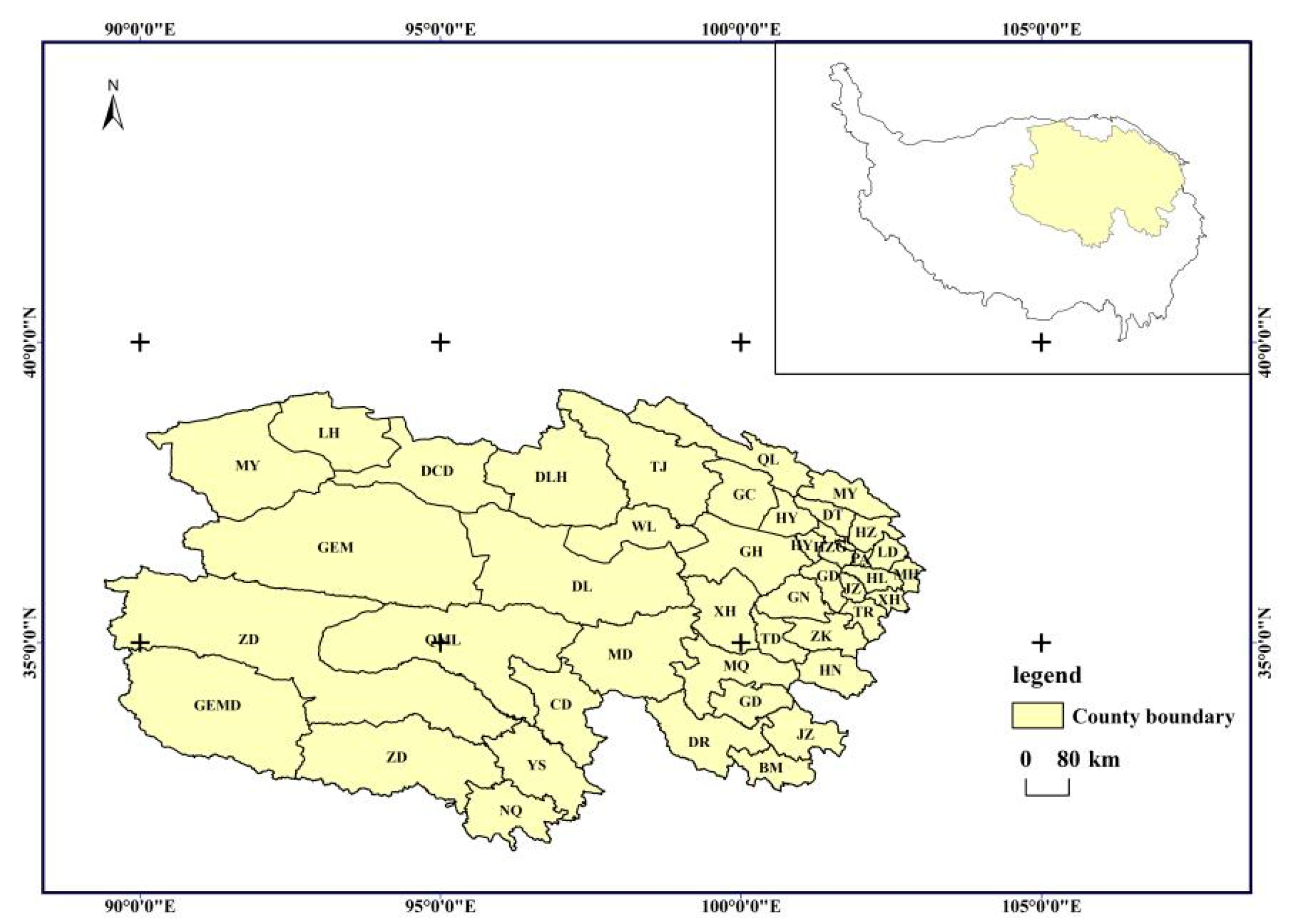
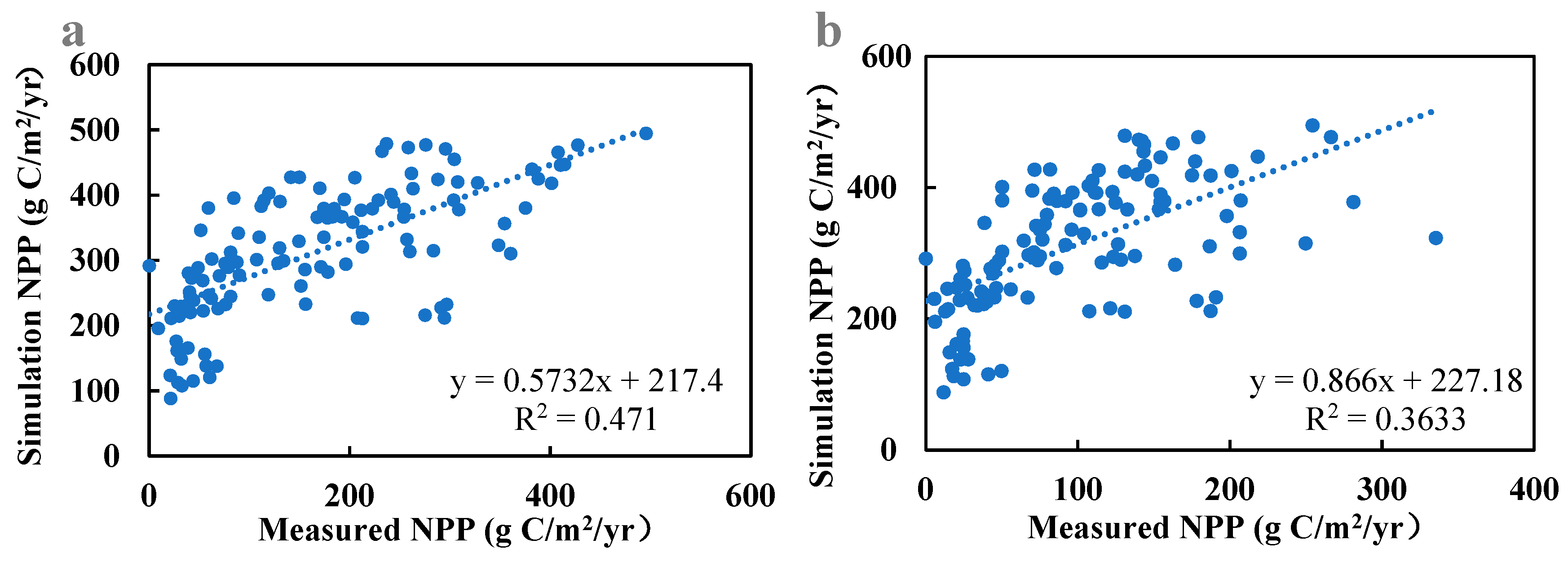
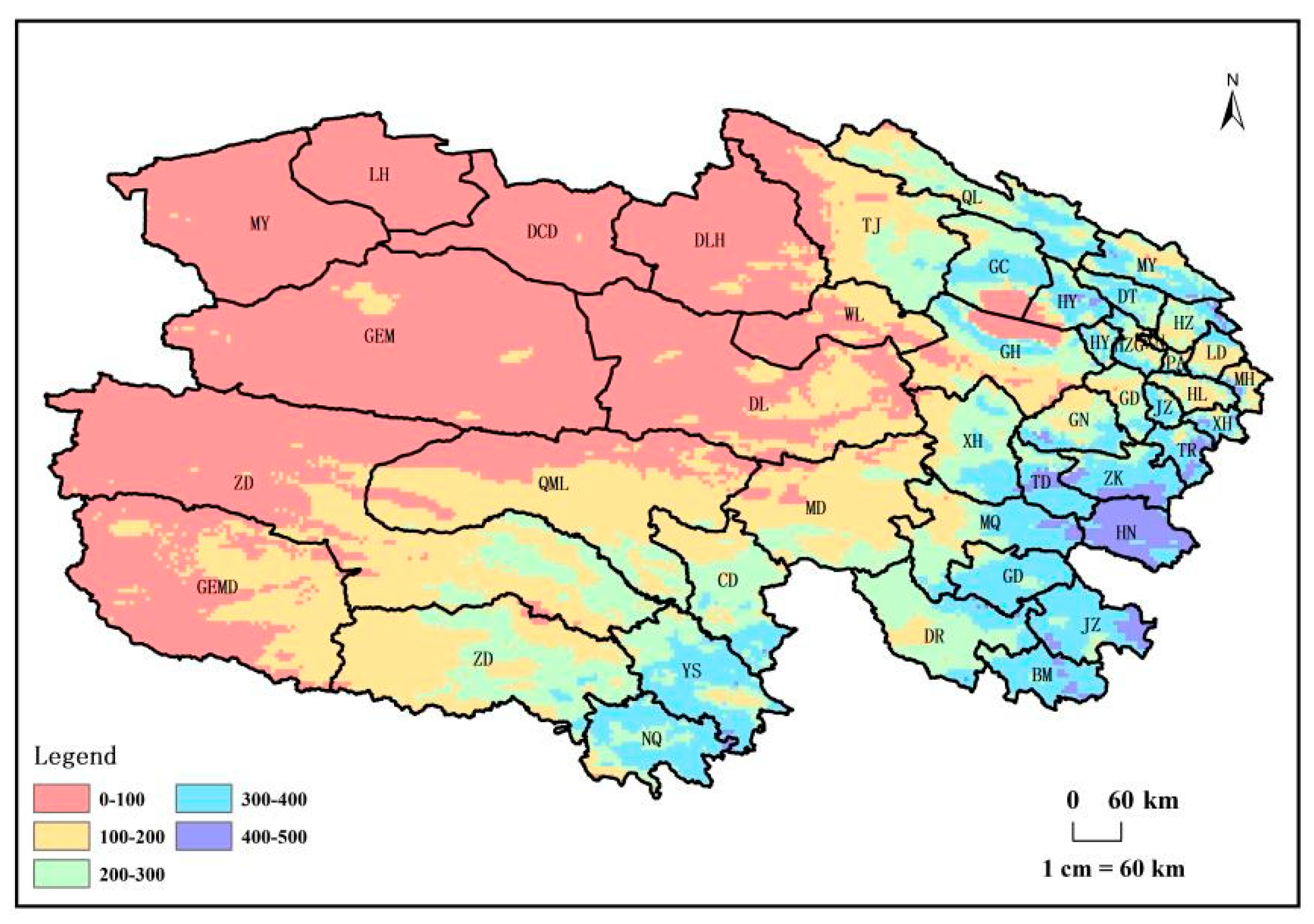
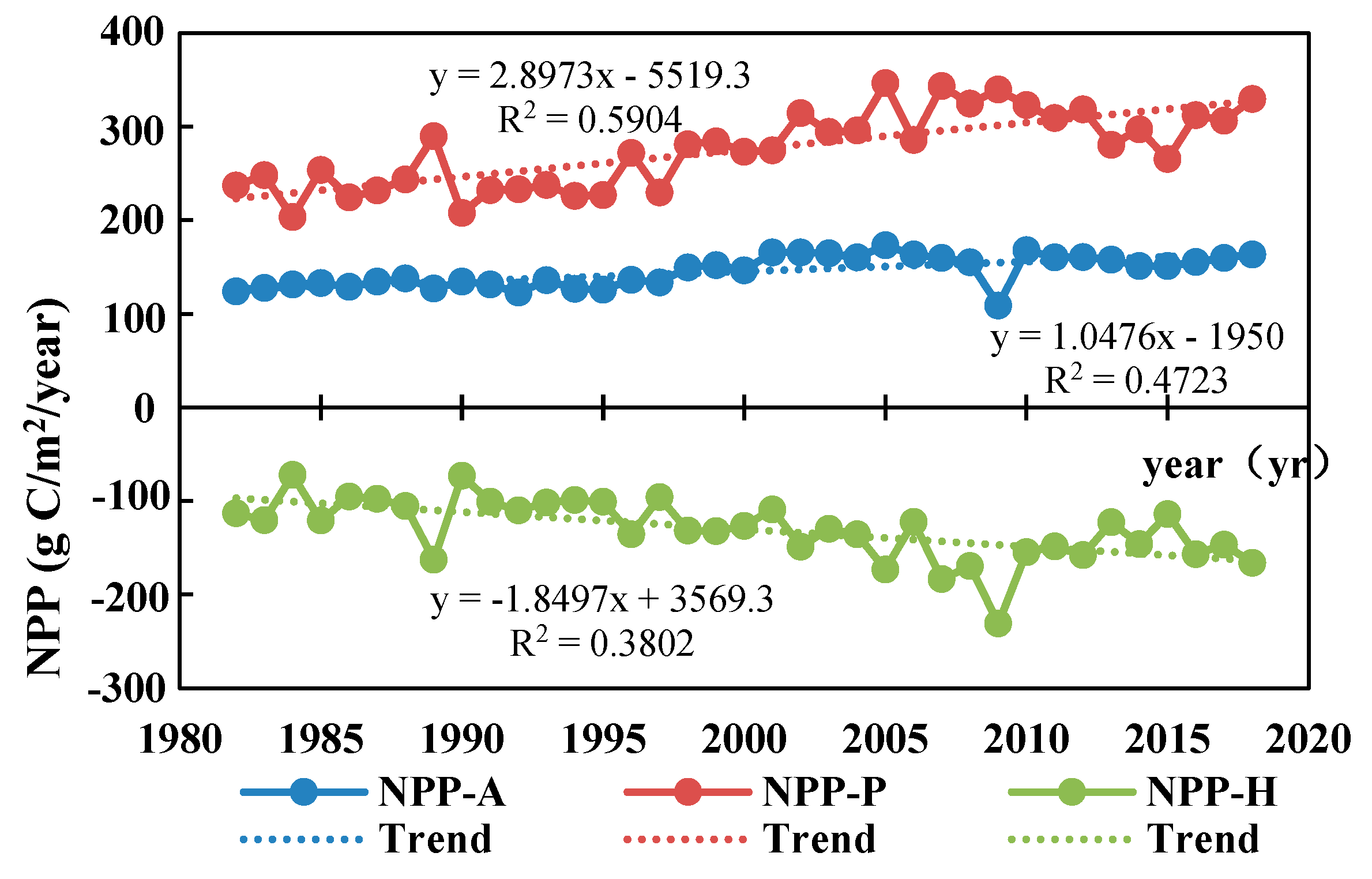
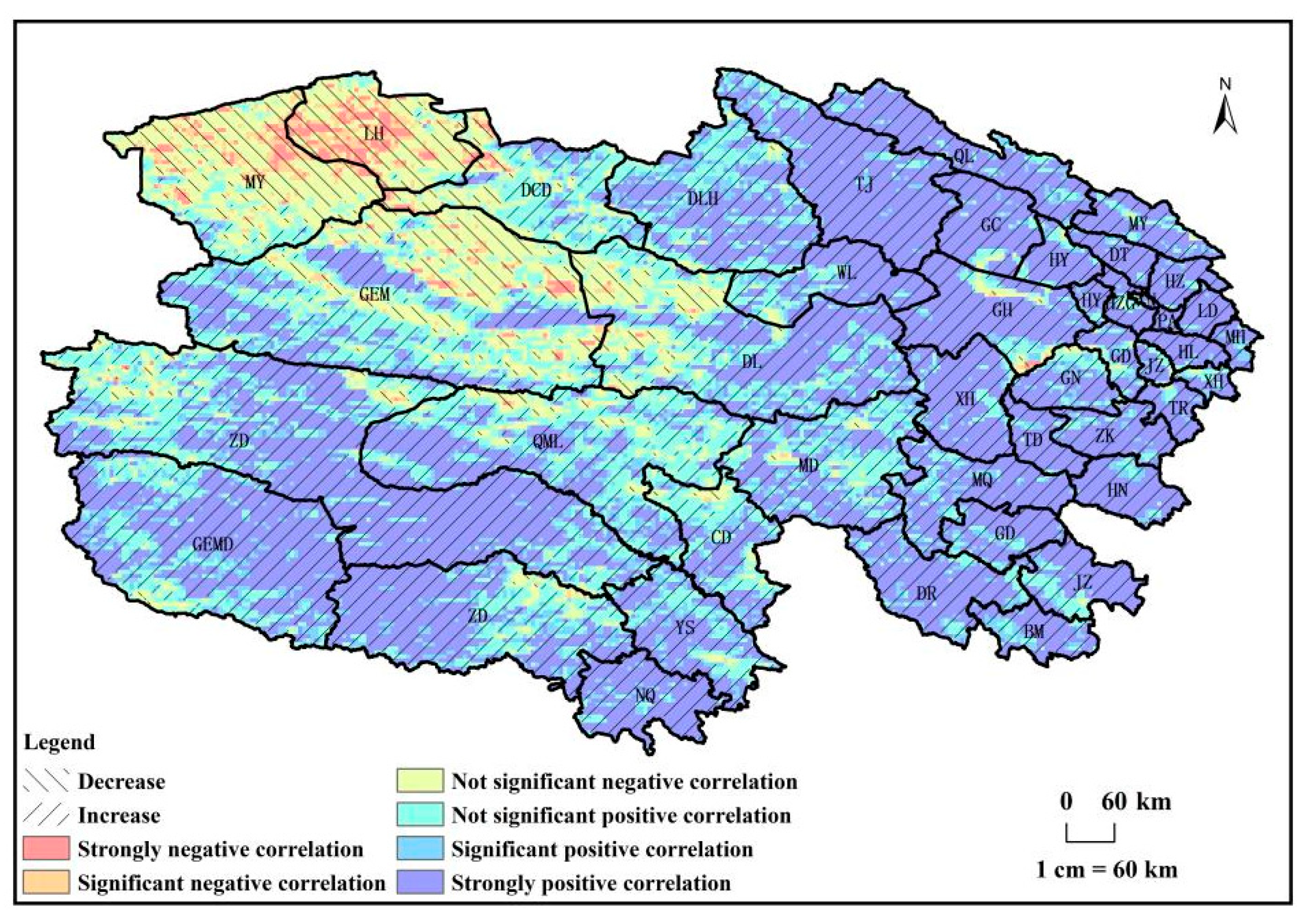
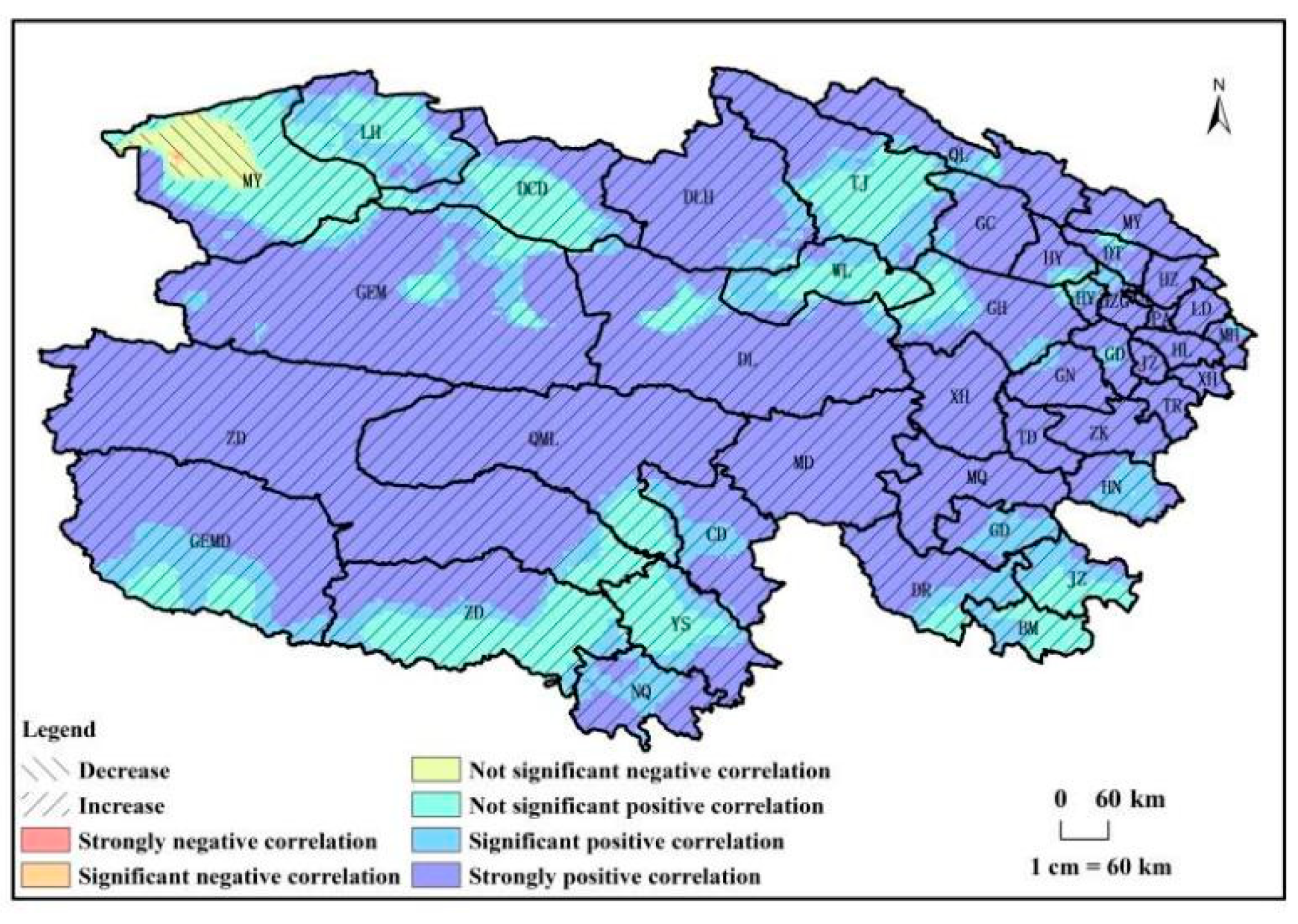
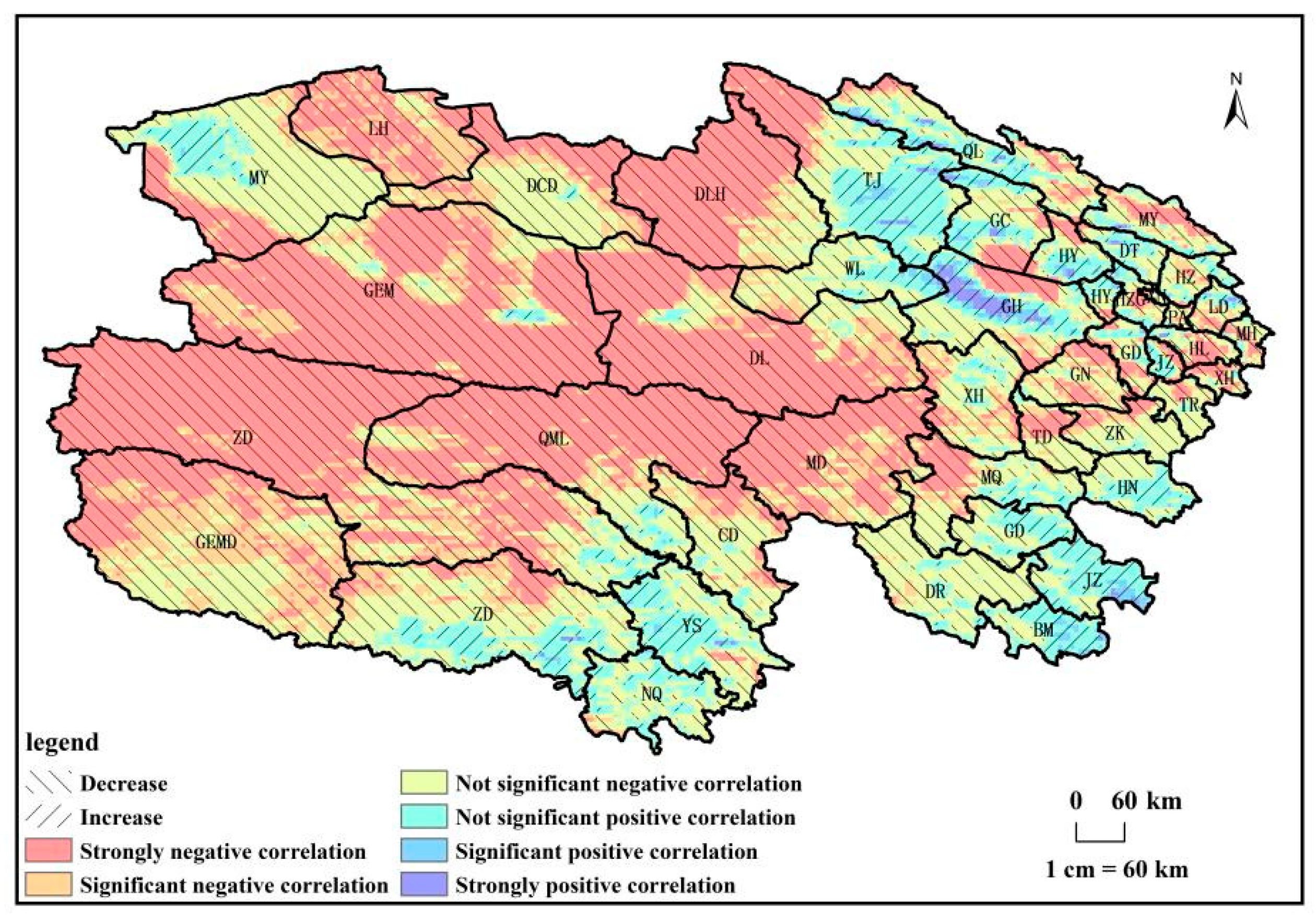
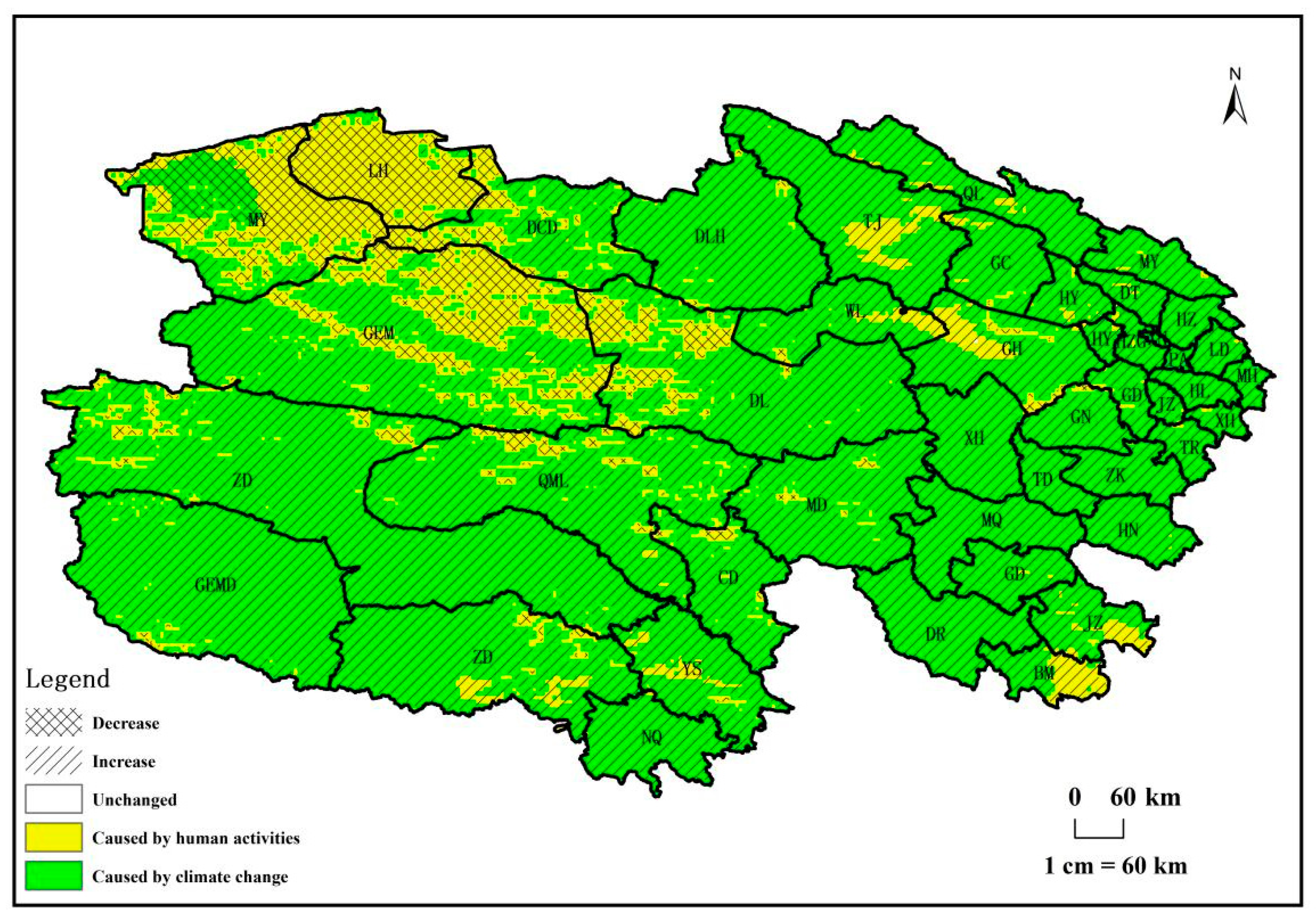
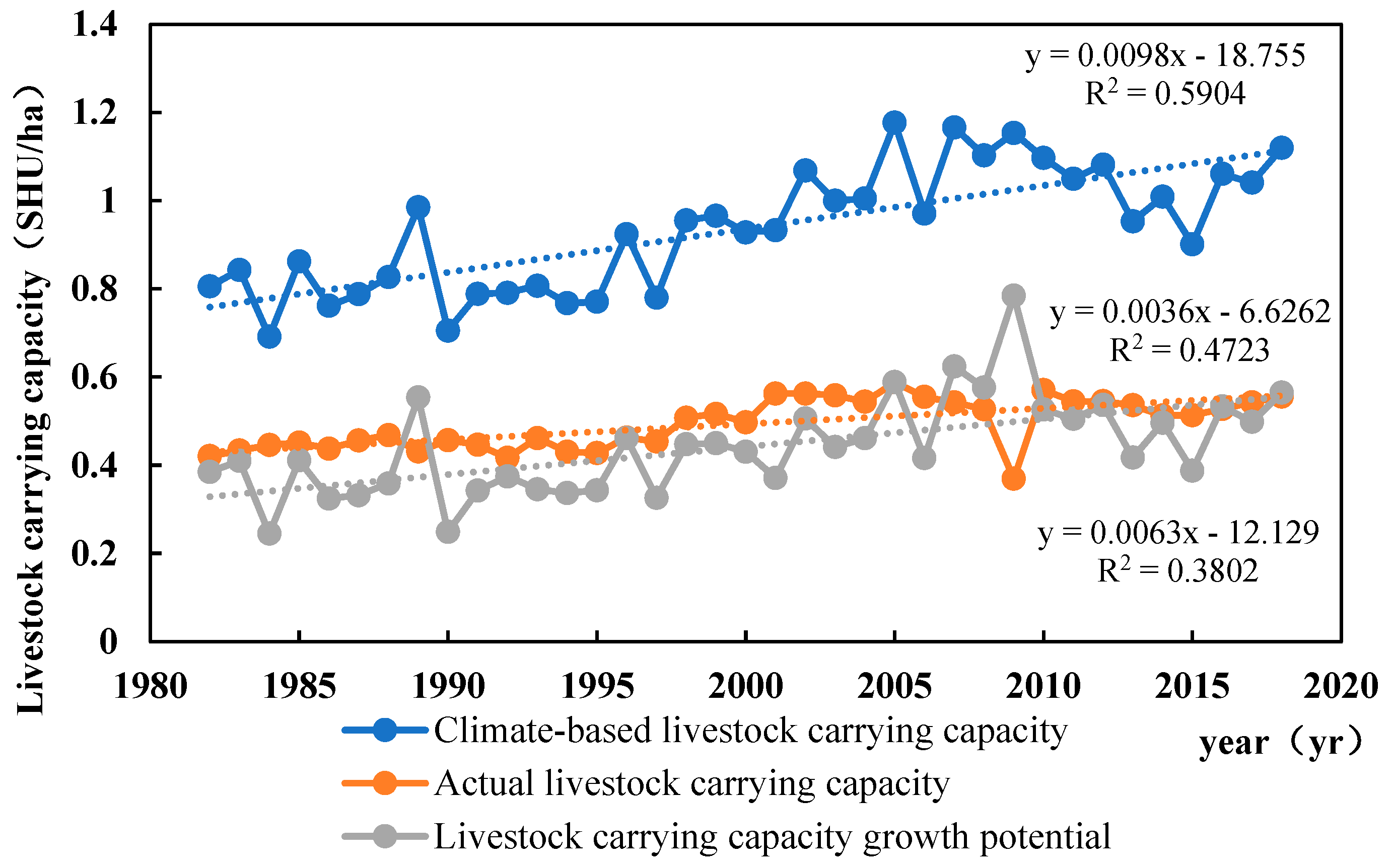
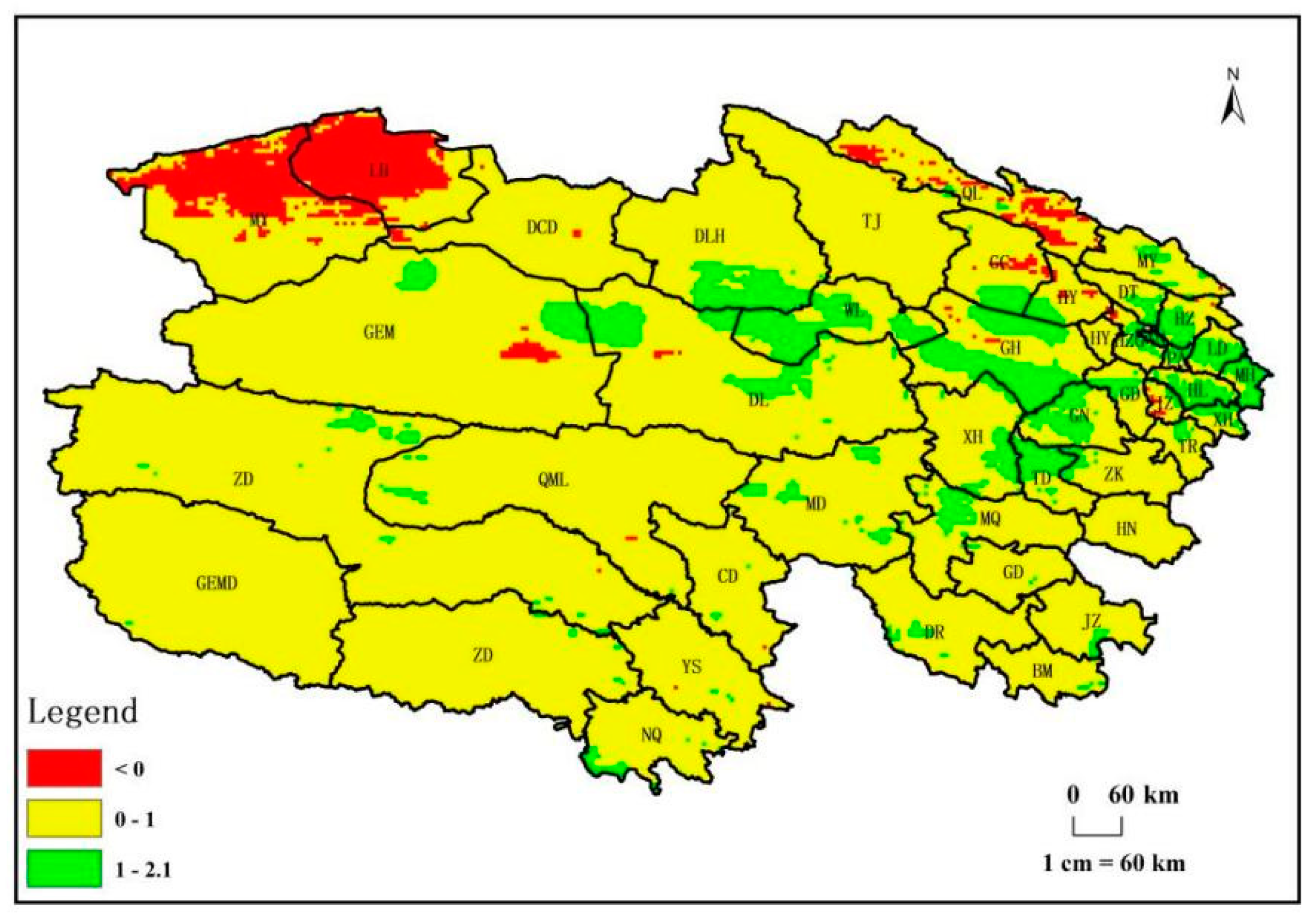
| Change State | Scene | Discrimination Method | Leading Drivers of Change |
|---|---|---|---|
| SA = 0 Vegetation remains unchanged | 1 | NPPA remains unchanged | |
| SA > 0 Vegetation restoration | 2 | |SP| > |SH| | Climate factors lead to an increase in NPPA |
| 3 | |SP| < |SH| | Human activities lead to an increase in NPPA | |
| SA < 0 Vegetation degradation | 4 | |SP| > |SH| | Climate factors lead to a decrease in NPPA |
| 5 | |SP| < |SH| | Human activities lead to a decrease in NPPA |
Disclaimer/Publisher’s Note: The statements, opinions and data contained in all publications are solely those of the individual author(s) and contributor(s) and not of MDPI and/or the editor(s). MDPI and/or the editor(s) disclaim responsibility for any injury to people or property resulting from any ideas, methods, instructions or products referred to in the content. |
© 2025 by the authors. Licensee MDPI, Basel, Switzerland. This article is an open access article distributed under the terms and conditions of the Creative Commons Attribution (CC BY) license (https://creativecommons.org/licenses/by/4.0/).
Share and Cite
Wei, Q.; Zhou, B.; Wang, W. Qinghai Province (Tibetan Plateau): Quantifying the Influence of Climate Change and Human Activities on Vegetation Net Primary Productivity and Livestock Carrying Capacity Growth Potential. Biology 2025, 14, 494. https://doi.org/10.3390/biology14050494
Wei Q, Zhou B, Wang W. Qinghai Province (Tibetan Plateau): Quantifying the Influence of Climate Change and Human Activities on Vegetation Net Primary Productivity and Livestock Carrying Capacity Growth Potential. Biology. 2025; 14(5):494. https://doi.org/10.3390/biology14050494
Chicago/Turabian StyleWei, Qian, Bingrong Zhou, and Wenying Wang. 2025. "Qinghai Province (Tibetan Plateau): Quantifying the Influence of Climate Change and Human Activities on Vegetation Net Primary Productivity and Livestock Carrying Capacity Growth Potential" Biology 14, no. 5: 494. https://doi.org/10.3390/biology14050494
APA StyleWei, Q., Zhou, B., & Wang, W. (2025). Qinghai Province (Tibetan Plateau): Quantifying the Influence of Climate Change and Human Activities on Vegetation Net Primary Productivity and Livestock Carrying Capacity Growth Potential. Biology, 14(5), 494. https://doi.org/10.3390/biology14050494





